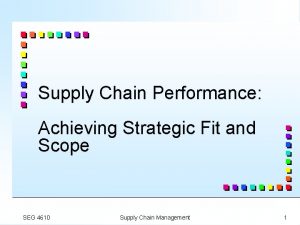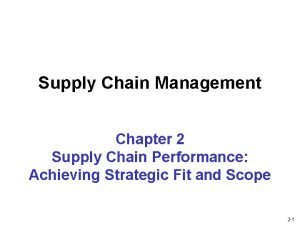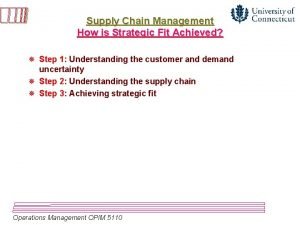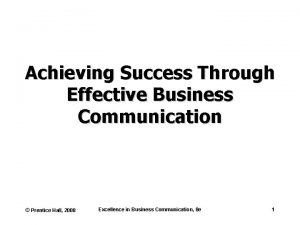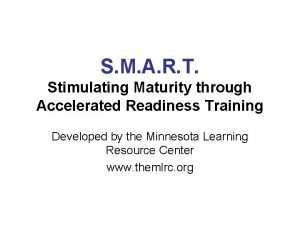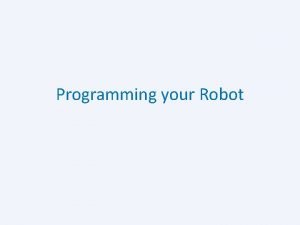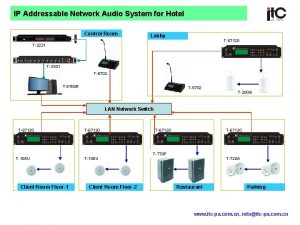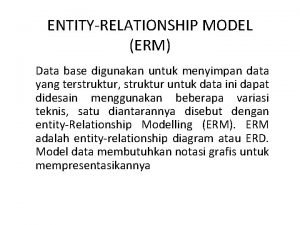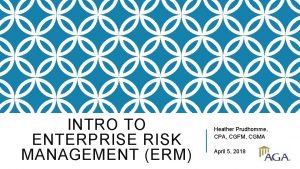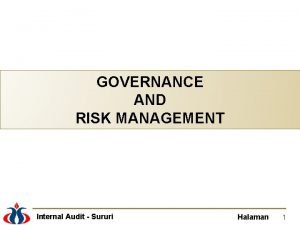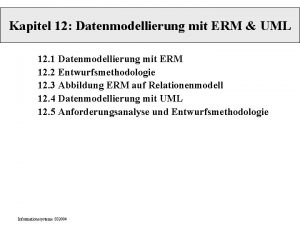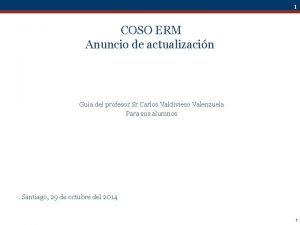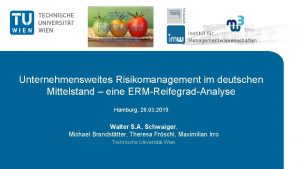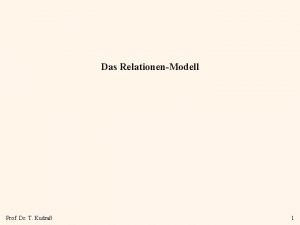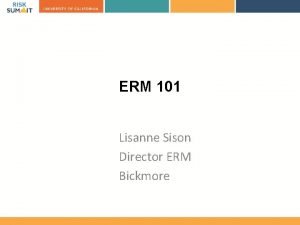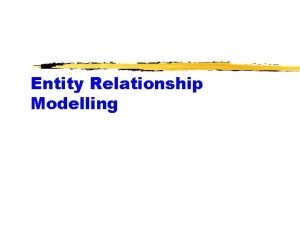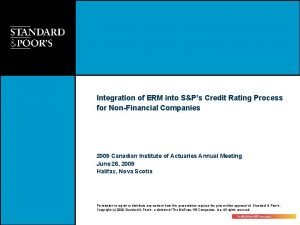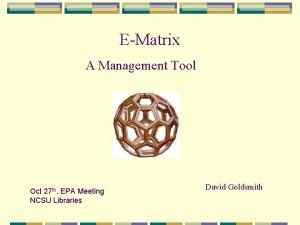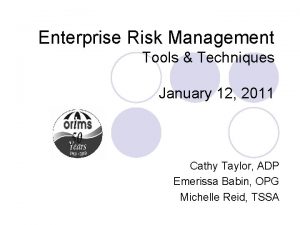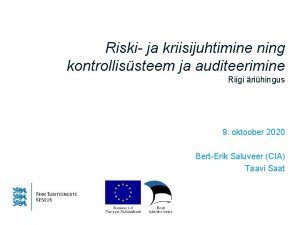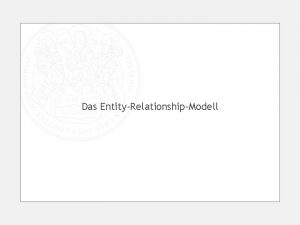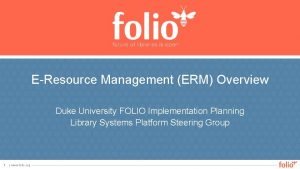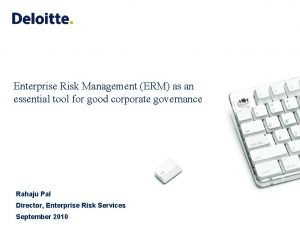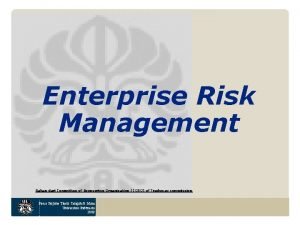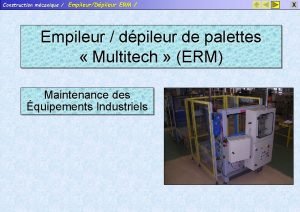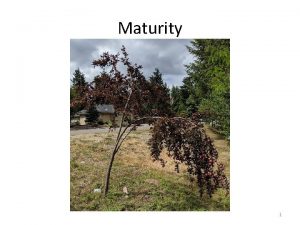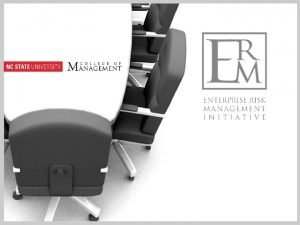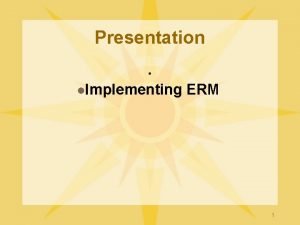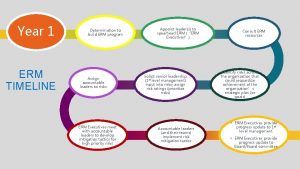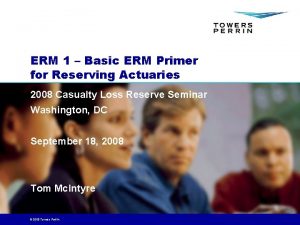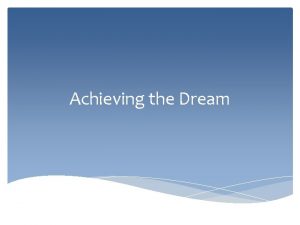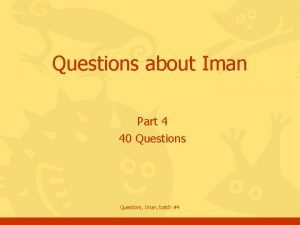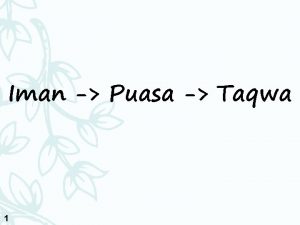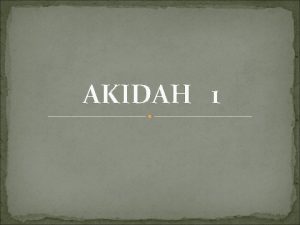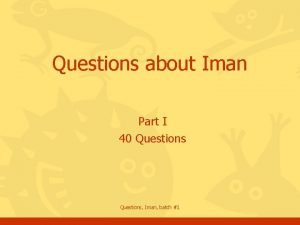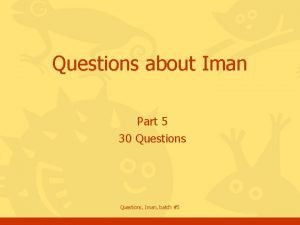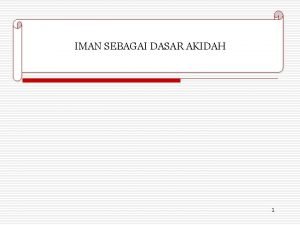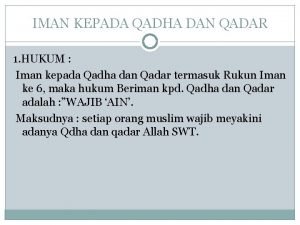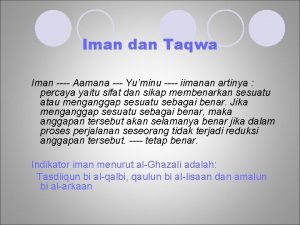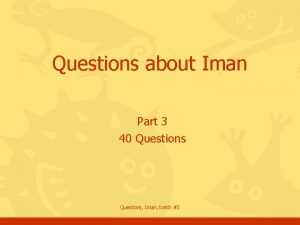Achieving results through strategic ERM maturity Speakers Iman












































- Slides: 44


Achieving results through strategic ERM maturity

Speakers Iman H. Al-Gharabally ERM Team Leader Corporate Risk Management Department igharaba@kpc. com. kw

Today’s agenda • Introductions, overview and foundation for maturity • The KPC ERM journey • Transformation • Challenges • Results • Closing comments and Q&A

Do some risks matter more than others? Peter Went, GARP

Which risks are you accountable for? Strategic Operations Financial External • • • Capital • Cash flow • Credit • Debt obligations • Foreign exchange • Liquidity • Etc. • Economy • Environment • Geopolitical • Regulatory • Tax policies • Weather events • Etc. • • • Acquisitions Business Model Competition Demographic Changes Disruptive innovation Market Etc. Customer service Infrastructure Processes System capabilities Talent Etc. THE RISK TYPE SPECTRUM

Key sources of value destruction Source: Corporate Executive Board

FREQUENCY/LIKELIHOOD Choosing your risk range focus SEVERITY/IMPACT

Seven important characteristics of risk maturity models 1. Risk appetite management – Policy to lead decision making and responsibility within guidance 2. Managerial support within the corporate culture 3. Unites events with process sources 4. Executing strategy and vision using the balanced scorecard 5. Revealing risks – assessing risks to document both risks and opportunities 6. Business sustainability – seamless integration to operational planning 7. Source: Risk Methods

RIMS risk maturity model Adopt ERM Approach Denotes the degree of executive support for an ERM-based approach within the corporate culture. Activities cut across all processes, functions, business lines, roles and geographies. ERM Process Management Degree that a repeatable and scalable risk management process is integrated into business and resource/support units, using a sequential series of steps that support uncertainty reduction and promote opportunity exploitation. Risk Appetite Management Degree of accountability for (1) defining acceptable boundaries 2) calculating and articulating risk tolerance 3) developing a risk portfolio 4) considering scenarios, and 5) attacking gaps between perceived and actual risks. Root Cause Discipline Degree of discipline applied to measuring root cause by: 1) determining sources 2) understanding impacts 3) identifying trends, and 4) measuring effectiveness of controls. Copyright ERM, LLC, where not otherwise claimed

RIMS risk maturity model Uncovering Risks Degree of quality and coverage (penetration) throughout the organization for uncovering uncertainties related to organizational goals achievement. Performance Management Degree to which organizations are able to execute on vision and strategy in tandem with risk management activities. Business Resiliency and Sustainability Extent to which an organization integrates business resiliency and sustainability aspects for its operational planning into its ERM process. Copyright ERM, LLC, where not otherwise claimed

Aon risk maturity model • A participative and comparative vehicle by ratings • Characteristics: • • • Board understanding and commitment Executive level risk stewardship Risk communications Culture, engagement and accountability Risk identification Stakeholder participation Risk info and decision making processes Integrating risk and human capital processes Analysis, quantification and demonstrated value Focus on value creation

Protiviti’s risk maturity perspective • Responding to risks that matter most • 6 infrastructure elements that advance maturity • • • Policies Processes People & organization Reports Methods and assumptions Systems and data • Board questions • Five levels of maturity • Stages of a capability maturity framework

Key considerations • No “one size fits all” • Correlation among attributes • Risk as an integral aspect of strategy • Value additive considerations • Executing vision and strategy guided by risk • Integration of risk tactics into key processes • Key actions that drive value gains • Integration as a driver for uncovering new risks • A 25% firm value premium • Doing what your firm needs and supports

What really matters? Communication Clarity Understanding & Interpretability Consistency Gumption & Influence Risk Efficiency and Effectiveness Downside Protection Value Creation

What really matters? Embedded risk culture Reliable measurability Process rigor Risk Efficiency and Effectiveness Managing to appetite & tolerances Aligning or integrating with strategy

Kuwait Petroleum Corporation • The national oil company of Kuwait • Operates in exploration and production, refining, petrochemical and transportation • Activities concentrated domestically with increasing growth overseas KPC Upstream Midstream Downstream • Overseas expansion mostly through joint ventures and joint operations • Production currently in excess of 3, 127, 000 million BPD and 120 million SCFD of associated and free gas • Petrochemical business focused on polyolefins, aromatics and glycols KOC KOTC KNPC KGOC IM KPI • Turnover – KD 29. 085 bn (2010/11) • Assets – c. KD 30 million (2012/13) KUFPEC PIC • Capex in fixed assets KD 1. 5 bn (2010/11) • Number of employees – c 18338 KAFCO

KPC ERM journey • Corporate Risk Management Department formed in 2002; essentially an insurance buyer of standard energy policies • Defined an Enterprise Risk Management (ERM) Strategy in 2005 based upon the principles of COSO and the AZ/NZS 4360: 2004 Risk Management Guidelines • Implemented first phase of strategy through 2006 and 2007 with following features: • ERM Policy created • Subsidiaries implemented policy at subordinate level • ERM Framework and procedures introduced • Semi qualitative risk matrix and risk register developed • Integrated processes adapted and deployed • Early risk quantification of some key risks • Resource growth and capability building • ERM information system from Avanon introduced • Insurance programs continue to be adapted • In 2009 our ERM maturity was deemed to be comprehensive • ERM 2030 Strategy developed in 2010 with implementation beginning September 2011, aimed at placing KPC ERM at the strategic maturity level

Avanon Op. Risk Suite Op. Risk Reporting Module (ORM) Action Tracking Module (ATM) Self Assessment Module (SAM) Indicator Rating Module (IRM) Quants. (QTM) Administration Management Module (AMM) Identify Risks Analyze Risks Integrate Risks Evaluate Risks Assess Risks Treat Risks Monitor & Review Establish the Context Communicate & Consult Loss Tracking Module (LTM)

ERM capability maturity model Maturity 2014 Level 5 Strategic Level 4 Integrated Level 3 Comprehensive 2010 Level 2 Fragmented Level 1 Initial/Ad Hoc Description Commentary Risk management is built into decision-making. The organization selectively seizes opportunities because of its special ability to exploit risks. • Focus on value creation and preservation • Institutionalized • Confidence in ability to manage risks based on track record Risks are treated as a portfolio at the enterprise level and are correlated and aggregated across risk types and business units. • Calculation of risk measures that can be aggregated • Risk treatment integrated and costs optimized Risk management is enterprise-wide and encompasses all risk types including strategic and operational. • • Risk management functions independently within business units. Risk types managed are limited to hazard, financial, and compliance. • Capabilities vary across BUs • No cross-BU coordination • Some expertise within limited number of risk types such as market, credit, or hazard Risk management activities are ad hoc. No overarching risk management philosophy or objectives are defined. • Success depends on individuals • People are unaware of risks • Risks managed reactively 2002 SOURCE: Deloitte & Touche Risks clearly linked to strategic objectives Defined and documented Forward looking Clear accountability

Moving towards quantifying risks and using risk-based metrics to take strategic and investment decisions Most financial institutions use RAROC in their investment decisions Natural resources corporations also use risk-based quantitative metrics for appraising their investments, although the actual metrics vary Company Example risk-based metrics 1 Decisions impacted ▪ ▪ ▪ P 10 and P 90 of project value Value at risk (P 50 -P 10) IRR at risk ▪ ▪ Investment decision Project prioritization ▪ ▪ Expected NPV (P 50) P 10 and P 90 of project value ▪ Projects prioritization ▪ Net income distributions ▪ Portfolio risk-return assessment vs. risk appetite ▪ ▪ IRR at risk ▪ Prioritization of small projects ▪ Prioritization of major mining projects ▪ Full NPV and IRR proba-bility distribution curves Cumulative NPV distributions Project approval Portfolio selection ▪ Risk adjusted returns ▪ ▪ Project approval Portfolio selection All these metrics are covered by the risk-return quantification methodology 1 Metrics used in one or more major project / portfolio decisions in recent years; breath of applicability throughout organization varies SOURCE: Mc. Kinsey

The ambition to increase understanding of risk in strategic and investment decisions is in line with what we observe in the industry Question 29 – For which strategic decisions is risk management consulting mandatory? 8 7 Selected results of risk management readiness survey of 10 global oil & gas and mining companies 1 Total number of responses 7 7 Comments ▪ “We have people (that report to Risk) in every major business unit to closely support decision making” ▪ “We (risk) are very involved in supporting all key strategic decisions made by the company” 3 Strategic planning including capital allocation Funding strategy Evaluation of new investments Portfolio decisions Portfolio hedging Risk-return trade-offs are becoming increasingly important as companies focus on value rather than volume and the world is becoming increasingly volatile 1 Total of individual choices exceeds 10 as respondents were allowed to choose multiple options Source: Mckinsey & Co

Corporations across sectors are taking a hard look at how they manage risk Loss of confidence • “Given recent events, we have lost confidence in our ability to reliably anticipate, assess, and respond to our risks. ” Discontinuities • “We do not sufficiently understand how our risks are changing, as a result of changes in our environment or in our own strategy. ” Finding balance • “We need a better approach to ‘setting the dial’ on risk taking, to avoid whipsawing between too bold and too conservative” External scrutiny Efficiency • “We are under increasing pressure to bring our risk management to best-practice levels. ” • “Our risk management approach is too complex, bureaucratic, and ineffective. How can we refocus on value? ”

We are committed to transform risk management as a way to support our 2030 strategy KPC Vision and mission How ERM is supporting achievement of the overall vision of the Kuwaiti Oil Sector Vision: To reach leading global position in the oil and gas field through • An effective management tool to support better decision making • Being secure and reliable supplier of hydrocarbons • A much deeper understanding of major risks and how they affect the businesses and Oil Sector's ability to implement the 2030 strategy • Manage our operations with world-class HSSE standards • Being highly profitable and performance driven enterprise • Being one integrated company • Being employer of choice • Being positive role model for Kuwait • Suitable leading risk indicators and a good understanding how to quantify and assess the impact of a range of mitigation options • Ability to evaluate the investment portfolio from a risk adjusted point of view to create increased organizational value both at a KPC level and individual K-co level • The capability within the organization to conduct risk analysis and provide recommendations

KPC ERM objectives Three key objectives of KPC’s risk journey Achieve high certainty that the oil sector will meet the expectations of the State Ensure the availability of adequate funding to support oil sector capital expenditure Enable the oil sector to make a more fact-based and quantitative assessment of risk vs. return trade-offs in its activities and projects

Risk management should be based on an integrated approach with 5 key elements 1 Does your culture reinforce risk management principles? What formal and informal mechanisms support the right mindsets and behaviors? Are structures, systems, controls, and infrastructure in place for you to manage risk across the whole business? Is your governance model robust? Risk culture and performance transformation 5 Risk organization and governance 4 Insight and risk transparency 2 Integrated Enterprise Risk management Risk-related decisions and managerial processes Risk appetite statement, and strategy 3 Are critical business decisions made with a clear view of how they change your company’s risk profile? Do you understand your risks (in your current business as well as new businesses)? Can you measure them? Do you have true insight into risks that matter most? What is your overall capacity and appetite for risk? Which risks are you advantaged to own? Which should you transfer or mitigate?

We have a comprehensive list of initiatives in our 2030 risk journey to build our capabilities 1 • Achieve Quick-hit enhancements • Build an eminence program • Define risk governance • Develop risk management competency • Define appropriate at-risk-measures across KPC Risk culture and performance transformation 5 Risk organization and governance 4 Insight and risk transparency Integrated Enterprise Risk management Risk-related decisions and managerial processes • Aggregate risks across subsidiaries • Quantify KPC Group Risks 2 Risk appetite statement, and strategy 3 • Embed ERM in KPC day to day business • Allocate capital according to risk return profile • Appraise projects according to Risk Adjusted Return on Capital • Discuss risk appetite statements • Optimize risk financing

KPC risk journey aims at enhancing our institutional ability to manage risk exposure in an integrated fashion Initiatives with Mc. Kinsey support Initiatives implemented internally A Deploy appropriate at-risk measures across G B Quantify KPC Group Risks (using H ERM embedded in business KPC measures chosen in A) Quick hit enhancements C Aggregate risks within and across I Risk governance structure update D Deliver quantitative risk appetite and J Optimized risk financing E Perform project appraisal using Risk K Risk management competency subsidiaries tolerance statements Adjusted Return on Capital (RAROC) F Allocate capital based on a risk return profile development L Eminence building program

We have already developed and deployed tools to drive our transformation 1 Cash Flow at Risk reporting 2 Risk appetite statements 3 Capital project risk appraisal 4 Capital allocation based on risk return profile

Risks, risk modeling and metrics

Risk modeling aims to increase transparency and improve decision making KPMs help measure success of these directives…. KPC’s strategic directives (not exhaustive)… ▪ ▪ Upstream ▪ ▪ Downstream ▪ ▪ ▪ Midstream and others ▪ Increase crude production to 4. 0 mmbpd by 2020 Increase non-assoc. gas prod. capacities to 2. 1 Bcsf/d by 2020 … Grow domestic refining capacity to 1. 4 mmbpd (new built) and subsequent 1, 6 (tbc) mmbpd (enhancement of facilities) Increase refining complexity (CFP) … Human Capital attraction and retention … Profitability ▪ ▪ ▪ Profit margin ROACE … Costs ▪ ▪ ▪ Cost of risk R&T spend vs. plan … Production/ capacity ▪ ▪ ▪ Free gas production Proven reserves … HSEE ▪ ▪ ▪ Fatal cases Environmental incidents … ▪ ▪ ▪ Percentage of Kuwaitis in KPC Share of Capex spent locally … Kuwaitization and stakeholders Ability to attain targets on KPMs are influenced by multiple risks ▪ ▪ ▪ Strategic project risk Political/regulatory Operational/technical ▪ ▪ Portfolio/business risk Financial risks (counterparty, liquidity, market)

Model top risk effects via quantitative risk model Risk assessment $55 Forward Curve ▪ ▪ Capex Production disruption 22 18 20 14 20 20 10 Political 20 20 06 120 80 40 0 $35 ▪ ▪ Tax changes Nationalization Company portfolio Company-by-company profiles ▪ ▪ ▪ Cash flow at risk model Technical Price Quantitative risk model Project valuation model Production Capex Opex Growth projects/Strategic initiatives Risk return portfolio model

Top 10 KPC risks Top risks 3 step approach to arrive at list of top 10 risks for KPC ▪ Evaluate high and very high risks from bottom up KPC risk registry ▪ Compare with risks most important to Oil and Gas industry in top-down review ▪ Map risks against KPC Political/ regulatory risk 1 External influence on key decisions 2 War or political instability in the region Strategic project risk 3 Large project execution risks Portfolio/business risk 4 Disruptions in hydrocarbon market due to demand shifts in import countries Financial risk (Counterparty, Liquidity, Market) 5 6 Global crude/gas price volatility and related country/credit risk Refining/petrochemical margins and related FX risks strategic directives 7 Operational/ technical risk 8 HSSE and HR risks Operational risks leading to unplanned shutdowns or other supply chain disruptions 9 New technologies risks 10 Company reserves

The impact of risks will be assessed by five key measures, in line with KPC and K-Companies KPMs Risk measures chosen on the basis of KPC and K-Companies KPMs ▪ For financial KPMs (e. g. , ROACE), cash flow identified as main driver of uncertainty ▪ For non-financial KPMs, production and capacity levels identified as most impactful factors Risk measures Probability distribution variable Cash flow for KPC and Subsidiaries ▪ Annual cash flow for next year(s) (operating cash flow) ▪ Annual cash flow to both Kuwaiti government and KPC (remaining cash flow share) ▪ Annual crude capacity ▪ Annual associated and non-associated gas production ▪ Annual refining capacity Financial risk measures Stakeholder and KPC cash flow Crude capacity Non-financial risk measures Gas production Refining capacity

Architecture: 4 modules centralized at KPC and 7 modules maintained at K-Company level 1 Assumptions master 2 4 Shared engine KPC CFAR model KPC level 3 K-companies have option to change shared assumptions for running their own scenarios but the changes will be reflected for other K-Companies only if KPC implement the changes centrally 5 Shared K-company run data 14 KGOC CFAR KNPC CFAR … KPI CFAR PIC CFAR KOC CFAR K-Company level 35 SOURCE: Team analysis

Each K Company has it’s own risk model; output measures risks modelled both in deterministic and stochastic cases Relevant risk factors Financial models War/political scenario … Project delays Oil price Model output KPI KNPC KOC Financial ▪ All relevant risks modeled for all K Companies ▪ Focused risks modelled in detail for K Companies ▪ Deviation from base case due to each of these risks modelled separately ▪ All 9 K companies deterministic financial cash flows is modelled ▪ For each of these deterministic, the impact of all relevant risks modelled separately for output Non-financial ▪ Cash flow ▪ Varies by K distribution (by company each risk type ▪ For KGOC and KOC for each K – Oil capacity Company) – Gas production ▪ For KNPC – Refining capacity

The risk-return quantification methodology adds probabilistic metrics on top of the current appraisal and strategic metrics Value metrics Return metrics Time metrics Metrics currently used for program appraisal 1 Additional risk-adjusted metrics introduced by the methodology ▪ NPV ▪ Expected NPV ▪ ▪ IRR Profitability index ▪ ▪ Expected IRR RAROC (Risk adjusted return on capital) ▪ Payback period ▪ Expected payback period ▪ Sensitivity of NPV to – CAPEX overrun – Oil price – Project delay Scenarios ▪ ▪ NPV at risk (NPVa. R) Probabilities – To breakeven – To meet baseline Sensitivity/ Scenarios ▪ ▪ Stress-test expected economic performance of the project Prioritize and assess magnitude of key risks to focus mitigation actions Estimate likelihood of project success and the underlying value to the organization

Key risks identified specific to the project Relevance to project Oil price volatility Capex overrun ▪ ▪ Project execution delay Refining margins volatility Availability of feedstock ▪ Exposed to oil price volatility as oil is source of feedstock. Exposed to capex overrun and execution delay risk. The labor and equipment part of the capex is correlated with execution delay and the plant part is independent of it. The delay in project execution stretches the capex spend profile. Key parameters ▪ Crude price volatility of ~29% based on historical Brent prices ▪ Most likely overrun of 10%, between -5% to 40% ▪ Average delay of 11 months with a standard delay of 6 months Exposed to refining margins volatility as proceeds from product ▪ Average margin volatility of ~20% for the sales are sources of revenues various refined products ▪ Uncertainty in feedstock compositions at this stage results in uncertainty over which configuration will be selected. SOURCE: Illustrative- interviews with planning team and project team; interviews with SMEs ▪ Based on strategy with delay risk overlaid for each project

3 interlinked ERM quantitative processes Objectives CFa. R model Program-level risk-return quantification Portfolio-level risk-return quantification ▪ Provide a risk perspective on the FYP by introducing major risk factors ▪ ▪ Identify key risks for KPC and the State ▪ Provide a risk perspective on Program economics (including RAROC, Expected NPV, probability to break even) ▪ ▪ Identify key risks on a program ▪ Assess the risk return profile of different strategic options for the portfolio ▪ ▪ Support selection and definition of strategic directions Monitor evolution of risk exposures over time and against tolerance limits Quantify impact of mitigation actions and support creation of action plans Estimate the impact of strategic decisions on the portfolio Example output

Three challenges to meet our aspiration Build the conviction that risk management improves our performance and cost optimization Enhance risk capabilities throughout the organization Break silos to make people work together which strengthens the organization

We invite you to share and discuss how to overcome these challenges in ERM transformations

At the end of the ERM journey KPC has achieved strategic ERM maturity ü An effective management tool to support better decision making ü A much deeper understanding of major risks and how they affect the businesses and oil sector's ability to implement the 2030 strategy ü Concrete materials with quantification of the risks improving ability to engage the stakeholders in an informed manner ü Attention drawn towards the extreme tail risks facing the oil sector ü Suitable leading risk indicators and a good understanding how to quantify and assess the impact of range of mitigation options ü Ability to evaluate the investment portfolio from a risk adjusted point of view to create increased organizational value both at a KPC level and individual K-co level ü The capability within the organization to conduct risk analysis and provide recommendations

While we have made great progress more needs to be done to meet our aspiration Best practice observations 1 2 3 4 5 Insight and risk transparency Risk appetite and strategy Risk related decisions and managerial processes Risk organization and governance Risk culture and performance transformation ▪ Aggregated view of risks (risk taxonomy, risk register, cashflow@risk tools, heat maps and scenario planning) ▪ Model validation process by either external parties or risk corporate department ▪ Risk reporting system is aimed at decision support ▪ ▪ Explicit risk appetite statement ▪ Structured contingency plans to cope with major extreme events ▪ Risk management is at the core of company decision process regarding strategic and operational issues Peer best practice Relative position vs. peers KPC 2010 KPC Today 2017 KPC 2010 KPC Today Risk appetite statement implications are well understood and agreed ▪ Board is actively involved in risk management beyond “routine” approval of business plan ▪ Operational control and implementation is done at the executive level ▪ ▪ ▪ Peer average KPC 2010 KPC Today KPC 2017 Regular risk culture assessment Risk KPIs are built into performance evaluations Awareness programs to highlight progress of risk development/ transformation programs Note: Based on survey with 10 IOCs from Europe and US during H 2 2013 conducted by Mc. Kinsey & Co KPC 2017 KPC 2010 KPC Today

Thank You. Questions?
 Strategic fit means
Strategic fit means Implied uncertainty spectrum
Implied uncertainty spectrum How to achieve strategic fit in supply chain
How to achieve strategic fit in supply chain Specific gravity of fruits and vegetables
Specific gravity of fruits and vegetables Achieving through english module
Achieving through english module Achieving success through effective business communication
Achieving success through effective business communication Achieving success through effective business communication
Achieving success through effective business communication Strategic workforce planning maturity model
Strategic workforce planning maturity model Stimulating maturity through accelerated readiness
Stimulating maturity through accelerated readiness Agora speakers
Agora speakers Poet speaker
Poet speaker Language speakers
Language speakers Soundblock coaxial speakers creative commons pictures
Soundblock coaxial speakers creative commons pictures Currents and magnets summarizer
Currents and magnets summarizer Speakers
Speakers Speaker's tone
Speaker's tone All my sons act 1 quiz
All my sons act 1 quiz Agora speakers international
Agora speakers international Jos macau
Jos macau Marlon paz
Marlon paz Shira packer
Shira packer Dear distinguished guests
Dear distinguished guests Ad630 application notes
Ad630 application notes Audio system for hotel
Audio system for hotel Nnnn speakers
Nnnn speakers Generalitation
Generalitation Erm benefits
Erm benefits Komponen erm
Komponen erm Flugbuchungssystem
Flugbuchungssystem Coso
Coso Erm hamburg
Erm hamburg 1 zu 1 beziehung relationenmodell
1 zu 1 beziehung relationenmodell Redrapme
Redrapme Erm diagram
Erm diagram Sps erm
Sps erm Uncg erm
Uncg erm Er diagram multivalued attribute
Er diagram multivalued attribute Erm tools and techniques
Erm tools and techniques Erd vs erm
Erd vs erm Coso erm
Coso erm Min-max-notation
Min-max-notation Folio erm
Folio erm Risk intelligent enterprise
Risk intelligent enterprise Komponen coso erm
Komponen coso erm Erm construction
Erm construction
